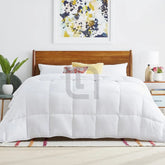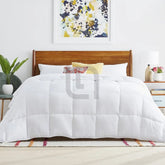Comforter Filling
- 10
- 15
- 20
- 25
- 30
- 50
- Featured
- Best selling
- Alphabetically, A-Z
- Alphabetically, Z-A
- Price, low to high
- Price, high to low
- Date, old to new
- Date, new to old
Sort by:
- Featured
- Best selling
- Alphabetically, A-Z
- Alphabetically, Z-A
- Price, low to high
- Price, high to low
- Date, old to new
- Date, new to old
-
Vendor: URBAN DECORIA
Comforter Filling – Queen
No reviewsComforter Filling – Queen This Comforter Filling is perfect for your queen-size bed, providing plenty of insulation and warmth for colder nights. Filled with superior quality material, you'll be sure to feel the difference as you rest comfortably. Perfect for curling up and staying...- Rs.4,499.00
Rs.5,500.00- Rs.4,499.00
- Unit price
- / per
-
Vendor: URBAN DECORIA
Comforter Filling – King
No reviewsComforter Filling – King This comforter filling is perfectly sized for king beds. It's made of superior quality materials to keep you cozy and comfortable all night long. Perfect for curling up and staying warm, a comforter like this is a great way to...- Rs.4,999.00
Rs.6,000.00- Rs.4,999.00
- Unit price
- / per
Comforter Filling Online in Pakistan
A comforter is a thick, quilted blanket that covers your bed and provides warmth and comfort. Comforters come in different sizes, colors, patterns, and styles, but one of the most important factors to consider when buying a comforter is the type of filling it has. The comforter filling determines how warm, fluffy, breathable, and durable your comforter will be. There are many types of comforter fillings available, each with its own advantages and disadvantages.
Types of Comforter Fillings
The most common types of comforter fillings are:
- Down: Down is the soft and fluffy plumage that grows under the feathers of ducks and geese. Down is one of the warmest and lightest natural fillings, as it traps air and creates a layer of insulation. Down comforters are very cozy and luxurious, but they can also be expensive and require special care. Down comforters are not suitable for people who are allergic to feathers or animal products. Down comforters have a fill power rating that indicates how much loft and insulation they provide. The higher the fill power, the fluffier and warmer the comforter. Down comforters usually have a fill power between 400 and 800.
- Wool: Wool is a natural fiber that comes from sheep and other animals. Wool is another warm and breathable natural filling that can regulate temperature and moisture. Wool comforters are ideal for cold climates, as they can keep you warm without overheating. Wool comforters are also durable, hypoallergenic, and resistant to dust mites and mold. However, wool comforters can be heavy, bulky, and hard to wash. Wool comforters are not recommended for people who are sensitive to wool or lanolin.
- Silk: Silk is a natural fiber that comes from the cocoons of silkworms. Silk is a luxurious and elegant natural filling that has a smooth and soft texture. Silk comforters are lightweight, breathable, and moisture-wicking, making them suitable for all seasons. Silk comforters are also hypoallergenic, antibacterial, and anti-inflammatory, which can benefit people with skin problems or allergies. However, silk comforters can be very expensive and difficult to clean. Silk comforters are prone to staining and fading.
- Cotton: Cotton is a natural fiber that comes from the cotton plant. Cotton is a popular and versatile natural filling that has a crisp and cool feel. Cotton comforters are lightweight, breathable, and absorbent, making them perfect for summer or warm weather. Cotton comforters are also easy to wash, hypoallergenic, and affordable. However, cotton comforters are not very fluffy or lofty compared to other natural fillings. Cotton comforters can also shrink, wrinkle, or lose their shape over time.
- Synthetic: Synthetic fillings are man-made fibers that mimic the properties of natural fillings. Synthetic fillings include polyester, microfiber, sustans, primaloft, loftaire, etc. Synthetic fillings are cheaper, lighter, and more durable than natural fillings. Synthetic fillings are also hypoallergenic, water-resistant, and easy to care for. However, synthetic fillings are not as breathable or insulating as natural fillings. Synthetic fillings can also trap heat and moisture, which can cause sweating or discomfort.
Advantages of Comforter Fillings
The advantages of different types of comforter fillings depend on your personal preferences and needs. Here are some general advantages of each type of filling:
- Down: Down is the warmest, lightest, fluffiest, and most luxurious type of filling. Down can provide excellent insulation without adding much weight or bulk to your bed. Down can also conform to your body shape and create a cozy cocoon.
- Wool: Wool is a warm, breathable, durable, and natural type of filling. Wool can regulate temperature and moisture well, keeping you comfortable in any season. Wool can also resist dust mites, mold, fire, and odors.
- Silk: Silk is a lightweight, breathable, moisture-wicking, and elegant type of filling. Silk can keep you cool in summer and warm in winter. Silk can also benefit your skin and hair by reducing friction and irritation.
- Cotton: Cotton is a crisp, cool, absorbent, and versatile type of filling. Cotton can keep you comfortable in warm weather or climates. Cotton can also be easily washed and maintained.
- Synthetic: Synthetic is a cheap, light, resilient, and hypoallergenic type of filling. Synthetic can mimic the loft and insulation of natural fillings without the drawbacks. Synthetic can also be water-resistant and easy to care for.
Usage of Comforter Fillings
The usage of different types of comforter fillings depends on your personal preferences and needs. Here are some general tips on how to use each type of filling:
- Down: Down is best used for cold weather or climates, as it can provide maximum warmth and comfort. Down is also suitable for people who like a fluffy and cozy feel. Down should be fluffed regularly to maintain its loft and avoid clumping. Down should be washed with care and dried thoroughly to prevent mold and mildew. Down should be stored in a breathable bag or cover to protect it from dust and insects.
- Wool: Wool is best used for cold weather or climates, as it can provide excellent warmth and breathability. Wool is also suitable for people who are allergic or sensitive to other types of fillings. Wool should be aired out regularly to keep it fresh and odor-free. Wool should be dry cleaned or hand washed with mild detergent and cold water. Wool should be dried flat or hung to prevent shrinking or stretching. Wool should be stored in a dry and dark place to prevent moth damage.
- Silk: Silk is best used for all seasons, as it can adapt to temperature and moisture changes. Silk is also suitable for people who want a luxurious and elegant feel. Silk should be aired out regularly to keep it fresh and smooth. Silk should be dry cleaned or hand washed with mild detergent and cold water. Silk should be dried flat or hung to prevent wrinkling or fading. Silk should be stored in a dry and dark place to prevent sun damage.
- Cotton: Cotton is best used for summer or warm weather or climates, as it can provide a cool and crisp feel. Cotton is also suitable for people who want a simple and versatile feel. Cotton should be washed regularly with mild detergent and warm water. Cotton should be dried on low heat or hung to prevent shrinking or wrinkling. Cotton should be stored in a dry and clean place to prevent dust or insects.
- Synthetic: Synthetic is best used for any season, as it can provide a moderate level of warmth and comfort. Synthetic is also suitable for people who are allergic or sensitive to natural fillings. Synthetic should be washed regularly with mild detergent and warm water. Synthetic should be dried on low heat or hung to prevent clumping or losing its shape. Synthetic should be stored in a dry and clean place to prevent dust or insects.
Conclusion
A comforter is a great way to add warmth, comfort, and style to your bed. However, choosing the right type of comforter filling can make a big difference in your sleep quality and satisfaction. There are many types of comforter fillings available, each with its own advantages and disadvantages. The best type of comforter filling for you depends on your personal preferences and needs, such as your budget, climate, allergies, etc. By knowing the main types of comforter fillings, their pros and cons, and how to use them, you can make an informed decision and enjoy your comforter for years to come.





